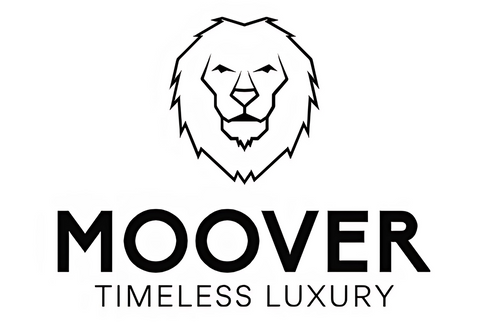Introduction
Wristwear has come a long way. From classic, mechanical watches that kept time with tiny gears to sleek, tech-powered devices, the shift has been dramatic. Today, smartwatches are everywhere. More people want them, and the way we see watches is changing fast. Is this the year that smartwatches fully take over traditional watches? With sales soaring and new features constantly arriving, that question gets more urgent. In 2025, it’s clear the battle between old and new is heating up—who will come out on top?
In a world of smartwatches and constant connectivity, MOOVER offers a refreshing return to timeless elegance. Our automatic watches are battery-free, precision-driven, and built for those who value heritage, craftsmanship, and enduring style.
→ Explore the MOOVER Collection: Where Tradition Meets Sophistication
The Growth and Adoption of Smartwatches in 2025
Market Trends and Sales Data
The worldwide smartwatch market keeps growing. In recent years, millions of these devices hit the shelves each quarter. Official data shows that in 2025, smartwatch sales are outpacing traditional watch sales. While traditional watches remain popular in some niches, the numbers prove a big shift. North America and Asia-Pacific regions lead the charge. These markets show a strong trend: consumers want more than just a watch—they want a device that connects and tracks health.
Consumer Demographics and Preferences
Who’s wearing smartwatches? Typically, younger age groups— teens and people in their 20s and 30s—are major buyers. They’re attracted to fitness tracking and instant notifications. Lifestyle also matters—people balancing busy schedules prefer the convenience of a smartwatch. Those who are tech-savvy or health-conscious tend to pick smart gadgets over traditional watches. This means familiarity with technology is a big factor in adoption rates.
Major Brands Leading the Shift
Big names like Apple, Samsung, Garmin, and Fitbit are dominating the smartwatch market with new models and features. Apple still holds the top spot, with its iWatch leading sales. Samsung and Garmin are catching up with innovations focused on fitness and health. Traditional brands like Rolex and Seiko are trying to stay relevant by introducing connected watches or blending classic style with modern tech. Still, they face a tough challenge competing against tech giants.
Features and Functionalities: Why Smartwatches Are Gaining Ground
Advanced Technology and Connectivity
Smartwatches now do more than tell time. They monitor heart rate, track steps, and even check your sleep. GPS helps you navigate, and voice assistants like Siri or Google Assistant let you control your device hands-free. These features make smartwatches essential for many daily routines. The best part? They connect directly to smartphones and smart home devices, making your tech ecosystem smarter.
Personalization and Versatility
One major advantage of smartwatches is customization. You can change watch faces, swap out bands, and set up notifications based on your needs. More than just a fitness tool, they are now mini computers on your wrist. They help with messaging, managing your calendar, and even paying for groceries through digital wallets. This versatility appeals to a broad range of users who want their watch to serve multiple roles.
Price Point and Accessibility
Smartwatches are getting cheaper, making them easier to buy. You don’t have to spend a fortune to get a good device. Entry-level models cost less than premium traditional watches, opening doorways for more buyers. With options at almost every price, smartwatches are broadening their reach.
Traditional Watches: Niche and Heritage in the Modern Era
Craftsmanship and Luxury Status
Old-school watches still have their charm. Luxury brands like Rolex and TAG Heuer stick to craftsmanship, using beautiful materials and fine details. For many, these watches symbolize status and success. They’re not just about telling time—they’re about making a statement. This timeless appeal keeps some buyers loyal, even as tech advances.
Limitations in Functionality
Traditional watches don’t have smart features. They can’t tell your heart rate or send notifications. They focus on aesthetics and craftsmanship, not tech. Still, they remain the preferred choice for collectors and enthusiasts who value history, design, and exclusivity.
Market Segments Where Traditional Watches Still Thrive
Luxury markets and collectors remain faithful to traditional, high-quality watches. Fashion brands also see value in limited editions and unique designs. They emphasize uniqueness and artisanal work, which smartwatches can’t replicate. For these groups, traditional watches stay relevant.
The Cultural and Fashion Perspectives
Changing Fashion Trends and Consumer Attitudes
Fashion is shifting toward a more tech-savvy, health-focused look. Wearing a smartwatch can showcase a modern lifestyle. Meanwhile, traditional watches symbolize elegance and tradition. People pick what fits their personal style, and both are here to stay.
Industry Insights and Future Predictions
Watchmakers and tech giants agree that both types will coexist. Experts say smartwatches will keep expanding their features, but traditional watches will remain symbols of craftsmanship and luxury. Having both styles caters to different needs and tastes. The future looks like a blend, not a replacement.
🕰️ Not All Innovation Is Digital
In a world dominated by smartwatches, MOOVER automatic watches offer timeless sophistication. Inspired by Swiss engineering and handcrafted in India, they remind us that true craftsmanship never goes out of style.
✨ Explore the MOOVER CollectionConclusion
In 2025, smartwatches are clearly gaining ground. Market data shows they are surpassing traditional watches in sales and popularity—especially among younger and tech-minded consumers. Still, classic watches hold their ground in luxury and craftsmanship. Both styles serve different purposes and continue to coexist. If you're choosing a watch today, consider your needs—tech or tradition? Your choice depends on whether you want convenience and connectivity or timeless elegance. Either way, the watch world is richer and more diverse than ever before.

